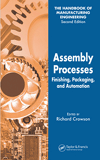
Because the customer had difficulty finding skilled maintenance technicians, Kinemetrix created a rich touch-screen interface so that startup, changeover and recover from abnormal conditions were straightforward. Photo courtesy Kinemetrix Industrial Design & Manufacturing Inc.
Such was the case for an automotive supplier that approached Kinemetrix Industrial Design & Manufacturing Inc. (Lexington, KY) to create an automated system for cladding wheels. Wheel cladding is a process in which a cosmetic skin is bonded to a generic wheel. The cladding can be chrome-plated plastic or stainless steel. The wheel can be cast aluminum or welded steel. The process enables the supplier to provide a variety of styling choices on a single wheel platform that has been optimized for strength and mass.
Automation was necessary because of the variety of parts to be assembled, rather than the amount. Indeed, the supplier produces wheels in an astonishing 128 variations, all of which are assembled on its automated line. The wheels are 15 to 20 inches in diameter and 6 to 12 inches wide.
Kinemetrix designed a nine-station asynchronous conveyor system equipped with multiple robots. The system assembles 200 wheels per hour. In this profile, Jim Peyton, president of Kinemetrix, outlines the system and explains his company’s “agile automation” approach. For more information, call 859-381-9937 or visit www.kinemetrix.com.
What equipment feeds the parts?Wheels are manually loaded via a servo-driven lift-assist device with custom universal tooling. Chrome-plated clads are shuttled into the cell by a six-axis robot equipped with an automatic tool changer.
What methods are used to assemble the product?A room-temperature vulcanizing adhesive in conjunction with mechanical undercut features secure the assembly. The adhesive is dispensed with automated metering equipment. Mechanical locking is accomplished via a custom servo-regulated pneumatic press.
What inspections are included?A vision system inspects wheel orientation. The amount of adhesive dispensed is measured in real-time and compared to control limits. Optical sensors confirm that plating tabs have been removed. Positional feedback on the assembly press confirms engagement of mechanical fastening. All assembly data is collected and stored to a database using radio frequency identification tags on the pallets. An inkjet prints an identification code on each wheel for traceability.
How did you help the customer design the product for assembly?We worked closely with the customer in the product development phase to improve the design and tolerancing of the mechanical interlocks. Using data from the manufacturing cell, we helped troubleshoot the product design and upstream manufacturing issues. Using actual process data really accelerates problem solving. No time is wasted on speculation.
Can the system accommodate product variants?The system accommodates all 128 variations. It is designed for a 4-minute tool-less changeover, but actual changeover times of 1.5 minutes have been documented. This is achieved through:
* automatic tool change system on the handling robot.
* universal wheel-handling tooling on the lift devices.
* tool-less, quick-change fixtures on the assembly pallets.
* automatic clamp-and-locate tooling for the assembly press.
* ID checks for all hard tooling ensure correct assembly and prevent tool damage.
* checking wheel orientation with machine vision rather than discrete sensors.
What was the most challenging aspect of the system?A significant challenge was that the product and process technology were relatively new. Many product details and production volume projections were vaguely understood. That put a lot of responsibility on us to provide a system with the flexibility to meet return-on-investment targets regardless of what curveballs were thrown after system handover.
After analyzing the customer’s current product designs, likely variations, development risks, product pipeline and volume projections, we employed an array of tools from our agile automation approach to system design. One of our design rules was, “If it touches the part, it requires tool-less changeover.” This helped the customer in its lean journey by minimizing work in process. In addition, modular tooling put few, if any, constraints on the customer’s designers as product designs evolved.
Another challenge was the customer’s difficulty in finding and retaining skilled maintenance technicians. That meant the equipment had to perform 24 hours a day with minimal maintenance and no on-site process engineering. We created a rich touch-screen interface so that startup, changeover and recovery from abnormal conditions were straightforward. Devising simple, robust controls and programming structures were essential to enable the customer’s technicians-some of whom had no robotics experience-to easily understand and support the equipment.
The agile approach enabled the customer to take on nearly a dozen new production programs in the first year of operation with minimal tooling cost and zero additional capital investment.
Agile features don’t always pass strict return-on-investment tests. Some manufacturers, particularly those practicing lean techniques, realize that there is a less quantifiable, yet equally tangible, return to be had by investing in flexibility. Responding quickly and economically to major changes in product mix and production volume is essential to the reality of today’s market. The success of this approach is probably best measured by the customer’s order for a second system to meet their growing demand.






